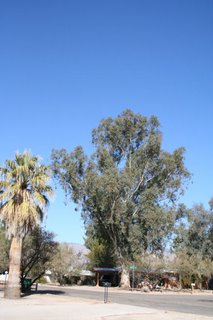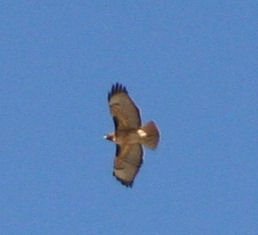For the third year in a row, the red-tailed hawks (Buteo jamaicensis) have returned to nest in the eucalyptus tree across the road.
 Preparing to hunt. The nest is in the lower right corner of the photo.
Preparing to hunt. The nest is in the lower right corner of the photo.
Take off.

Later today:

There's a wonderfully detailed article on the Red-Tailed Hawk on the University of Michigan Museum of Zoology Animal Diversity Web site. They quote:
Red-tailed hawks usually begin breeding when they are three years old. They are monogamous, and mate with the same individual for many years. In fact, red-tailed hawks usually only change mates when their original mate dies. During courtship, the male and female soar together in circles, with flights lasting 10 minutes or more. Mating usually takes place following these flights. The male and female land on a perch and preen each other. The female then tilts forward, allowing the male to mount her. Copulation lasts 5 to 10 seconds.This afternoon I heard the hawks calling and turned to see the pair circling together high in the east. What a privilege it is to live in the middle of a city and still be able to witness these beautiful birds mating and nesting so close by.

5 comments:
Absolutely fantastic shot. I try to photograph red-tailed hawks quite often, but never get their wings with such clarity. Wonderful.
You are lucky to have them nesting so close to you!
I only occasionally see Red-tailed Hawks in my neighborhood, and they are very difficult to photograph because they won't let me get anywhere near them.
Great shots Pam! Like Beth said, you're fortunate to have them nesting so closely... a wonderful experience I'm sure :)
Great pictures, especially the red-tailed hawk in flight.
Yesterday I saw a red-tailed hawk get a squirrel, How long before it needs to feed again? If it is feeding young in a nest how often do they need to hunt?
Thanks
Post a Comment